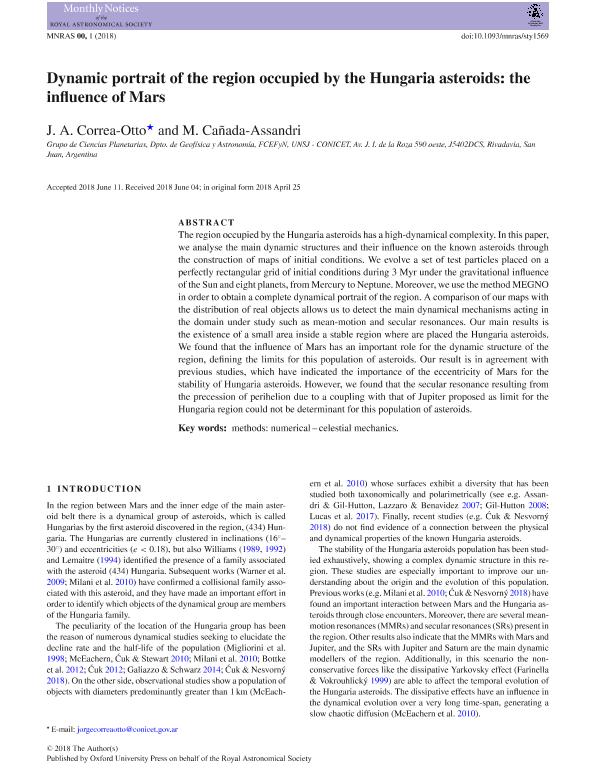Mostrar el registro sencillo del ítem
dc.contributor.author
Correa Otto, Jorge Alfredo

dc.contributor.author
Cañada Assandri, Marcela Inés

dc.date.available
2022-04-28T03:48:52Z
dc.date.issued
2018-06
dc.identifier.citation
Correa Otto, Jorge Alfredo; Cañada Assandri, Marcela Inés; Dynamic portrait of the region occupied by the Hungaria asteroids: the influence of Mars; Oxford University Press; Monthly Notices of the Royal Astronomical Society; 479; 2; 6-2018; 1694-1701
dc.identifier.issn
0035-8711
dc.identifier.uri
http://hdl.handle.net/11336/155958
dc.description.abstract
The region occupied by the Hungaria asteroids has a high-dynamical complexity. In this paper, we analyse the main dynamic structures and their influence on the known asteroids through the construction of maps of initial conditions. We evolve a set of test particles placed on a perfectly rectangular grid of initial conditions during 3 Myr under the gravitational influence of the Sun and eight planets, fromMercury to Neptune. Moreover, we use the method MEGNO in order to obtain a complete dynamical portrait of the region. A comparison of our maps with the distribution of real objects allows us to detect the main dynamical mechanisms acting in the domain under study such as mean-motion and secular resonances. Our main results is the existence of a small area inside a stable region where are placed the Hungaria asteroids. We found that the influence of Mars has an important role for the dynamic structure of the region, defining the limits for this population of asteroids. Our result is in agreement with previous studies, which have indicated the importance of the eccentricity of Mars for the stability of Hungaria asteroids. However, we found that the secular resonance resulting from the precession of perihelion due to a coupling with that of Jupiter proposed as limit for the Hungaria region could not be determinant for this population of asteroids.
dc.format
application/pdf
dc.language.iso
eng
dc.publisher
Oxford University Press

dc.rights
info:eu-repo/semantics/openAccess
dc.rights.uri
https://creativecommons.org/licenses/by-nc-nd/2.5/ar/
dc.subject
METHODS: NUMERICAL
dc.subject
CELESTIAL MECHANICS
dc.subject
MINOR PLANETS
dc.subject
ASTEROIDS: DYNAMICAL EVOLUTION AND STABILITY
dc.subject.classification
Otras Ciencias Naturales y Exactas

dc.subject.classification
Otras Ciencias Naturales y Exactas

dc.subject.classification
CIENCIAS NATURALES Y EXACTAS

dc.title
Dynamic portrait of the region occupied by the Hungaria asteroids: the influence of Mars
dc.type
info:eu-repo/semantics/article
dc.type
info:ar-repo/semantics/artículo
dc.type
info:eu-repo/semantics/publishedVersion
dc.date.updated
2022-04-26T16:47:53Z
dc.journal.volume
479
dc.journal.number
2
dc.journal.pagination
1694-1701
dc.journal.pais
Reino Unido

dc.journal.ciudad
Oxford
dc.description.fil
Fil: Correa Otto, Jorge Alfredo. Consejo Nacional de Investigaciones Científicas y Técnicas. Centro Científico Tecnológico Conicet - San Juan; Argentina. Universidad Nacional de San Juan. Facultad de Ciencias Exactas, Físicas y Naturales. Departamento de Geofísica y Astronomía; Argentina
dc.description.fil
Fil: Cañada Assandri, Marcela Inés. Consejo Nacional de Investigaciones Científicas y Técnicas. Centro Científico Tecnológico Conicet - San Juan; Argentina. Universidad Nacional de San Juan. Facultad de Ciencias Exactas, Físicas y Naturales. Departamento de Geofísica y Astronomía; Argentina
dc.journal.title
Monthly Notices of the Royal Astronomical Society

dc.relation.alternativeid
info:eu-repo/semantics/altIdentifier/doi/http://dx.doi.org/10.1093/mnras/sty1569
dc.relation.alternativeid
info:eu-repo/semantics/altIdentifier/url/https://academic.oup.com/mnras/article/479/2/1694/5037938
Archivos asociados
